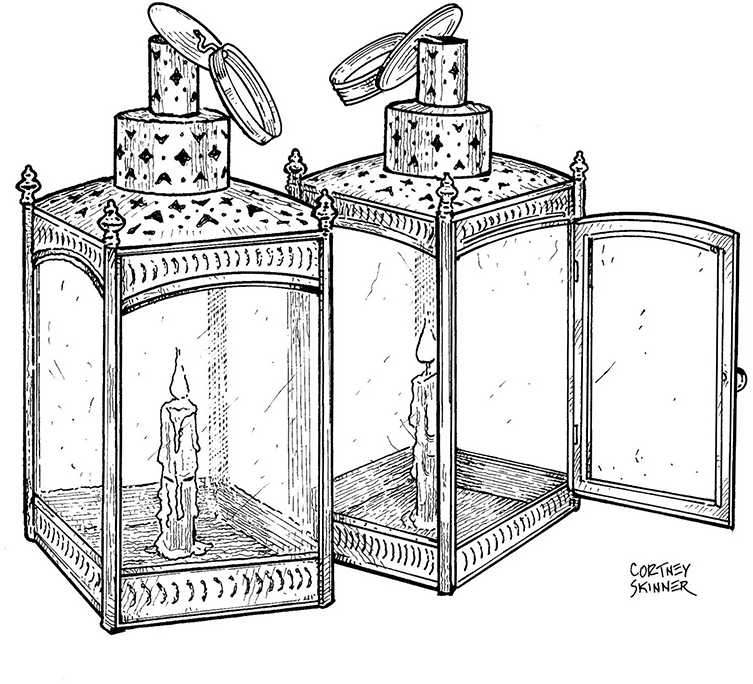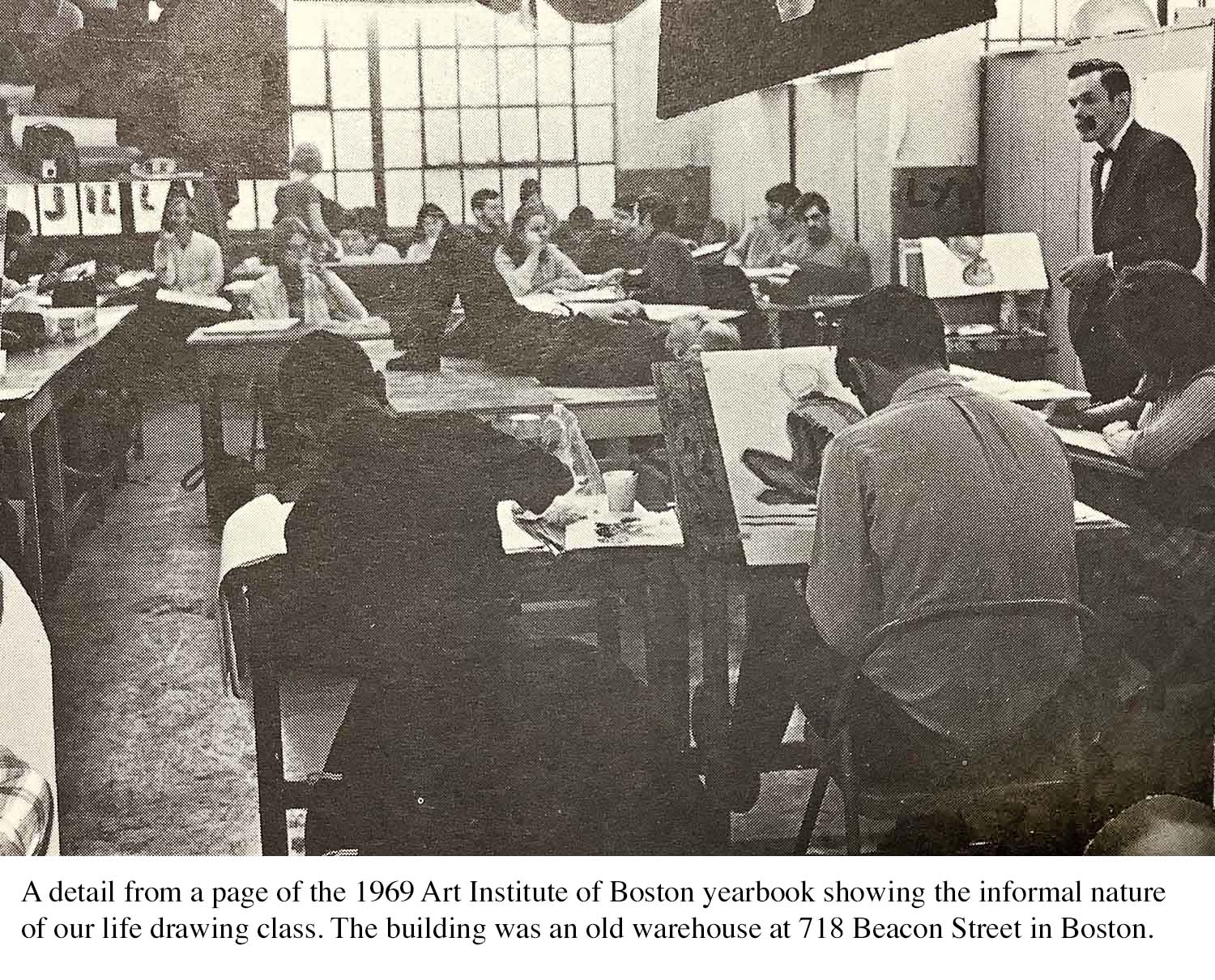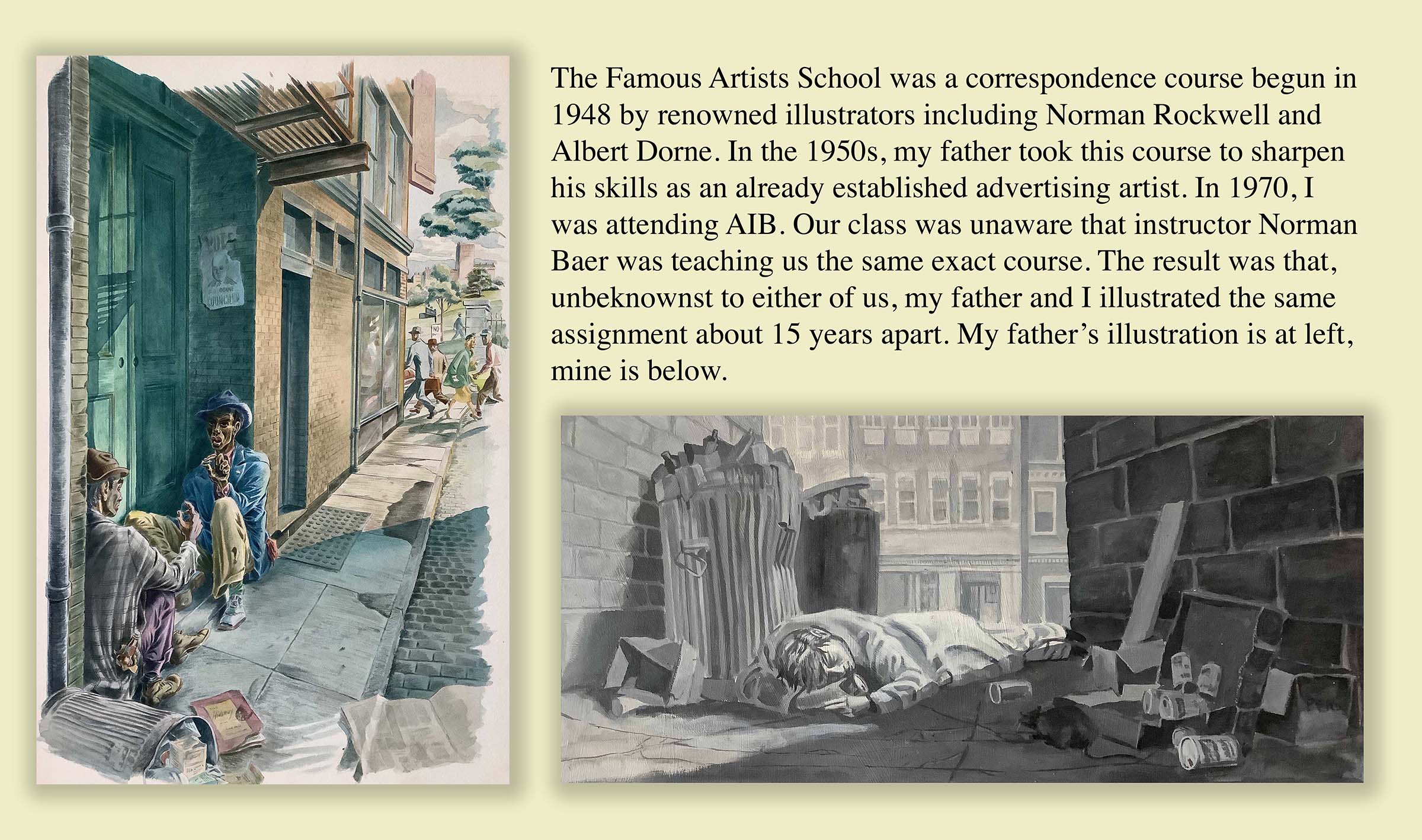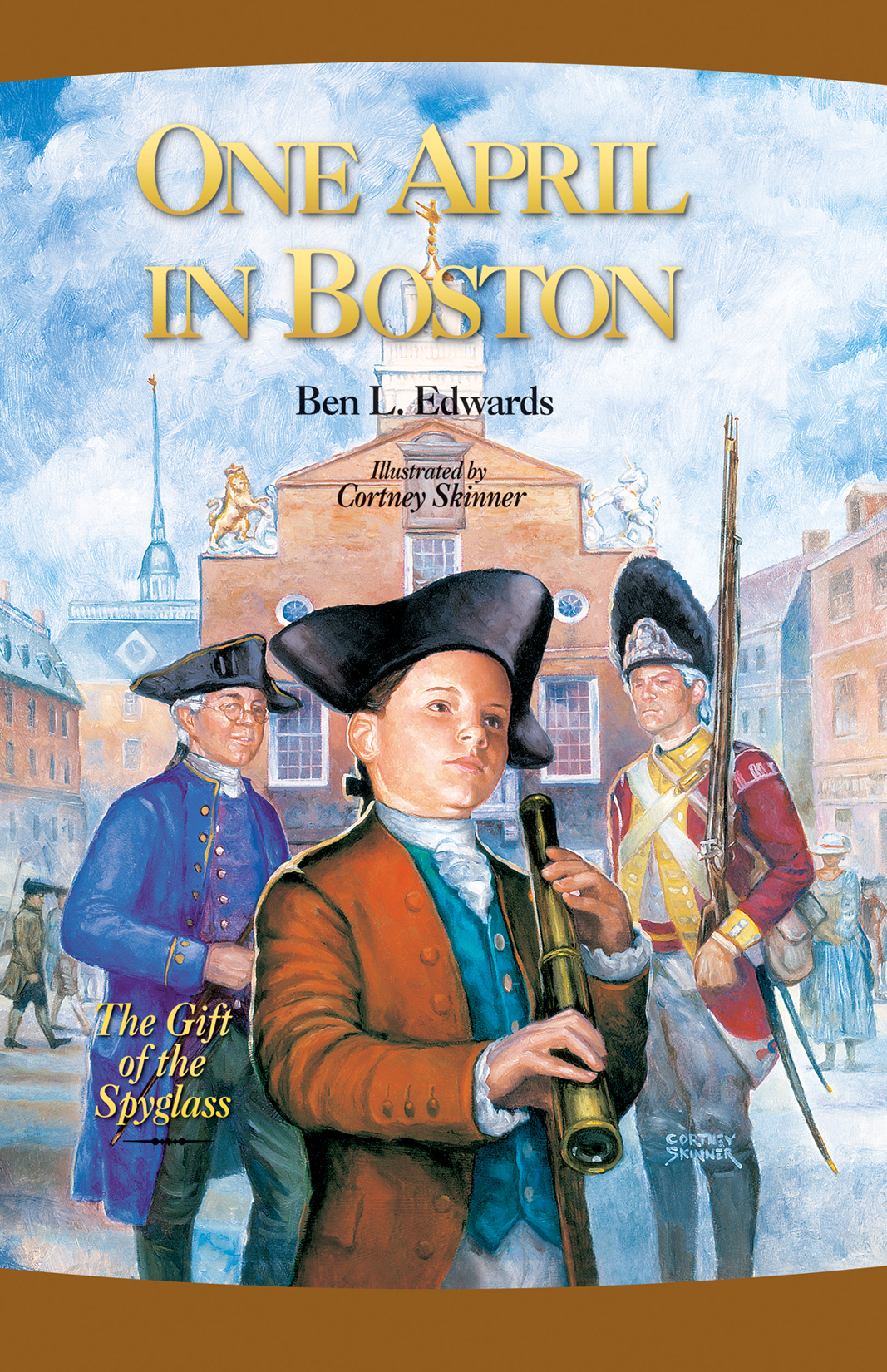One April in Boston
Howard Pyle Was My Great-Grand Teacher
The art of Illustration is a skill passed down directly or indirectly from illustrators of the past
by Cortney Skinner | 01.03.20
Illustrators are pictorial storytellers. In order to do their work, they also have to be highly imaginative, observant, and absorbent human beings who take in all sorts of influences around them: the natural world, the world of the arts, and the lessons taught them by other illustrators and artists, either in print or in person. Though accused of daydreaming by my grade school teachers, I prefer to think of it as being very observant of the world around me. That’s my story and I’m sticking to it.
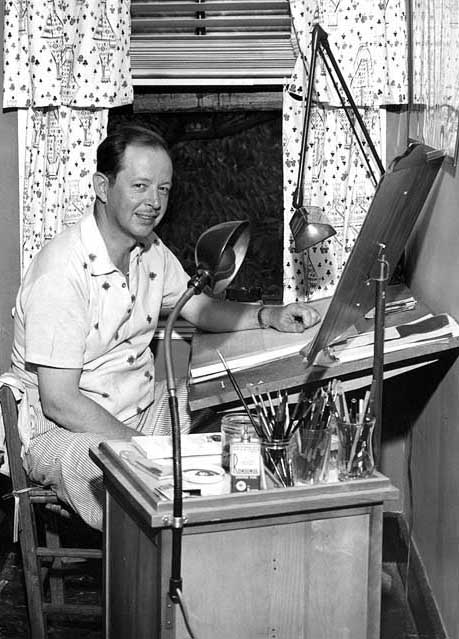 My father, Walter Skinner, pictured here, illustrated for his small Boston advertising firm founded in the late 1940s. It was a tough job, and I suspect that the challenges of raising a family of five kids on that salary might have been why he never encouraged me to enter the art field as a career. He’d spend long hours at his Boston office as well as up in his attic home studio at the end of the day, working at his drawing board on pressing deadlines for various ad campaigns. Downstairs, our living room bookshelves and tables were filled with dozens of my father’s books and magazines that carried covers and stories with pictures by amazing artists. Those pictures were all I needed for encouragement to be an illustrator. I’d pore over those publications and spend hours drawing—which is something I began at about age two, I’ve been told, but I’m sure I began my daydreaming in the womb.
My father, Walter Skinner, pictured here, illustrated for his small Boston advertising firm founded in the late 1940s. It was a tough job, and I suspect that the challenges of raising a family of five kids on that salary might have been why he never encouraged me to enter the art field as a career. He’d spend long hours at his Boston office as well as up in his attic home studio at the end of the day, working at his drawing board on pressing deadlines for various ad campaigns. Downstairs, our living room bookshelves and tables were filled with dozens of my father’s books and magazines that carried covers and stories with pictures by amazing artists. Those pictures were all I needed for encouragement to be an illustrator. I’d pore over those publications and spend hours drawing—which is something I began at about age two, I’ve been told, but I’m sure I began my daydreaming in the womb.
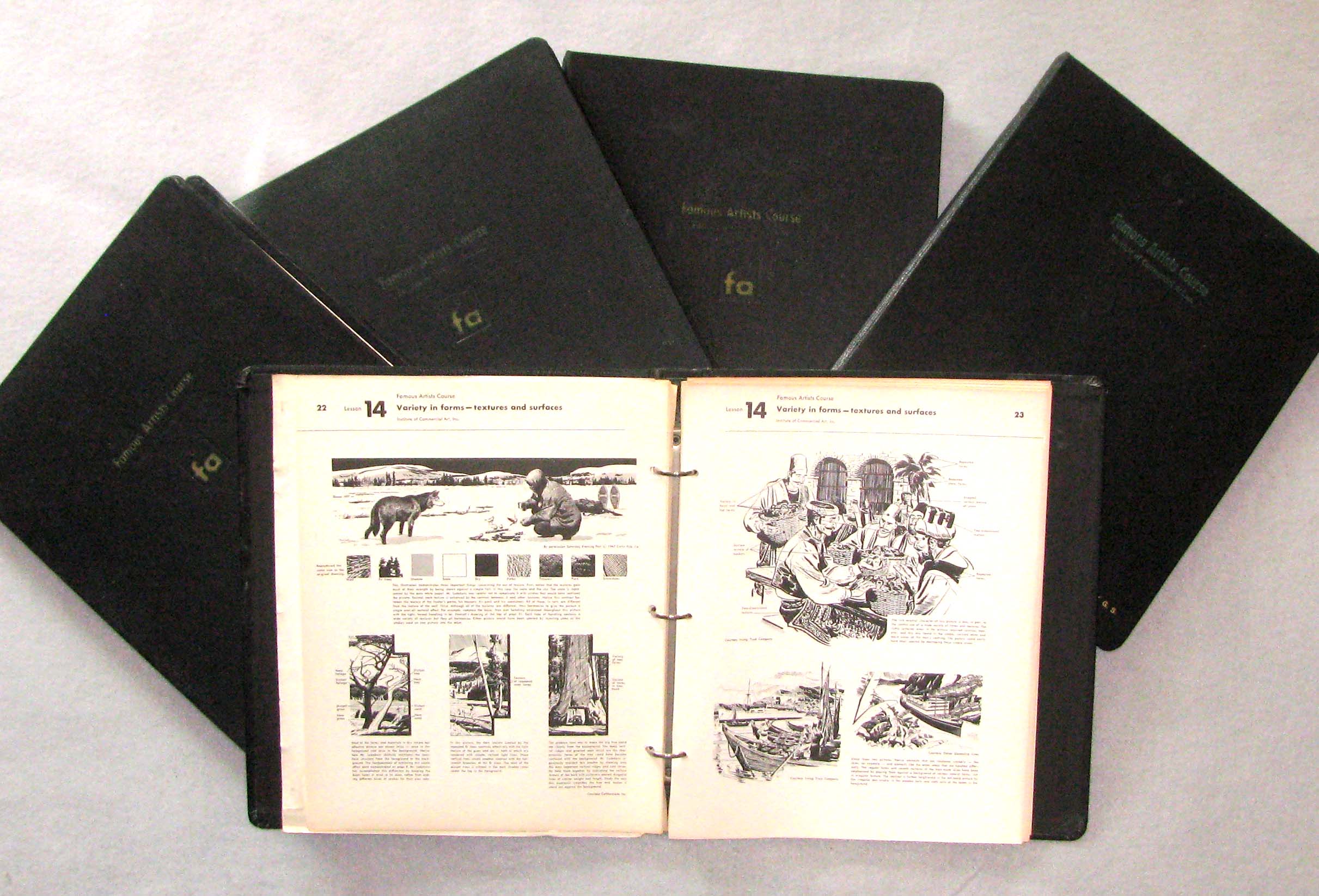 In the 1950s, to hone his own artistic talents, my father took the celebrated Famous Artists School correspondence course on illustration founded and taught by members of the New York Society of Illustrators, including Norman Rockwell. I still have his large 11” X 14″ binders of the FAS courses. These lessons were to have an unexpected impact on my own illustration education.
In the 1950s, to hone his own artistic talents, my father took the celebrated Famous Artists School correspondence course on illustration founded and taught by members of the New York Society of Illustrators, including Norman Rockwell. I still have his large 11” X 14″ binders of the FAS courses. These lessons were to have an unexpected impact on my own illustration education.
In American illustration, Howard Pyle and his circle are often seen as the creators of the “Golden Age” of illustration. It’s hard to find a modern illustrator not somehow influenced by Pyle’s work and approach to the craft. Rockwell was heavily influenced by Pyle’s teachings as well and, indeed, filmmakers have been inspired by Pyle’s vision. The short video at the end of this post, entitled “Howard Pyle and the Illustrated Story,” relates only a little about Pyle’s importance and his wide-ranging work in pictures and in prose.
It can be difficult to untangle or unravel all of the influences that an illustrator might have on their work. We illustrators are absorbing (and daydreaming) much of the time. Inspiration and life’s pathways can also vary over time, as can stylistic trends and industry standards. Though I admire and am inspired by many illustrators past and present, Howard Pyle’s approach to illustration might be the overwhelming influence to my own.
Though I was largely self-taught, my brief formal illustration instruction began after high school. Our next-door neighbor, Tom O’Hara, was an artist for NASA and he helped me to assemble my portfolio for applying at the School of Practical Art just outside of Kendall Square in Boston. It was a small, affordable three-year art school not offering any degrees but rather “practical art” instruction as the name suggested. The school was struggling at the time and in the fall, when my enrollment began, I was surprised to find that the school had changed its name to “The Art Institute of Boston.” It had also retooled its entire curriculum, discontinuing its cartooning program—which was the reason I had enrolled at the school in the first place. The only remaining course of instruction that interested me was illustration with Norman Baer who both taught and chaired the illustration department.
Naturally, in the 1960s, all art was done by hand. I won’t go into the details of our art instruction but suffice it to say that there was no digital technology and the techniques and methods of commercial illustration hadn’t changed much since Howard Pyle’s days. Norman Baer frequently invoked the name of Howard Pyle and his students, and with good reason. He had taken instruction from Harvey Dunn, one of Pyle’s students and an amazing illustrator in his own right. I guess that makes me a third-generation student of Pyle’s in a way—see the Illustrator Family Tree above. Norman Rockwell’s illustration methods were also taught in Baer’s class and (quite a few years later) a meeting with one of Rockwell’s students would pass on more inspiration and instruction. I’ll talk more about that in a future blog post.
Baer’s teaching method was a bear. There was no daydreaming in his classes. Highly dissatisfied with the illustration scene in New York City, he had left the business to teach at The School of Practical Art in 1962. He was able to communicate the difficulties and intricacies of illustration, but he was unable to convey much love for the art form, perhaps due to his own sad experiences. When the population of his classes dropped from two divisions of about 30 students each to one division of a dozen, the school administration made changes to ensure that the remaining students would elect to stay. Though his instruction was not very inspiring, at least he taught the basics of good illustration and with that knowledge, we each became the great-grand students of Howard Pyle. Interestingly enough, it turned out that much of the playbook that Baer was using came directly from the Famous Artists School. In fact, I found that my father and I had been given the exact same illustration assignment from the Famous Artists School course about 15 years apart—my father’s via the FAS and mine by Norman Baer via the FAS. I still have my father’s and my illustrations from the same assignment, see photo above.
My career as an illustrator began as a hobby that evolved into a part-time endeavor while working other jobs, eventually becoming a more than full-time vocation. Meeting other illustrators who became good friends ensured that skills and inspiration continued to grow and evolve. Education and the influences that inspire me continue right up to the present day… as does my daydreaming. More about all that in my next blog post. I have to go stare out the window.
Buy the Book Here
Direct from the Author
Paul Revere House - Boston
About This Blog
The Spyglass Blog was created to mark the 20th anniversary of the children’s book One April in Boston. Here the author and illustrator share the stories behind the illustrations, give insight into the artistic process, and introduce related artwork Ben Edwards shares on his Walking Boston private tour. SpyglassBlog.com
Subscribe
Receive notice by email when a new post has been added to the Spyglass Blog.
Meet the Author
Boston’s only private guided walking tour with a children’s book author and relative of Paul Revere. Details below.
Family Tours
Three private tour options. A fun and educational tour of the Freedom Trail your children will love! BostonFamilyTour.com
Field Trips
Field trips for the 2019-2020 school year are Sold Out. Booking now for the fall of 2020. BostonFieldTrip.com
Homeschool Groups
A unique field trip for homeschoolers that teaches your children American history and inspires them to create goals. Homeschool-FieldTrip.com
